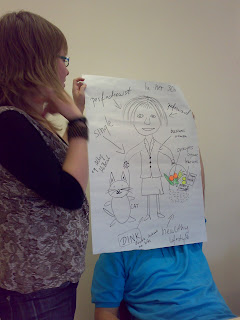Segmentation is essentially the identification of subsets of buyers within a market who share similar needs and who demonstrate similar buyer behavior. The world is made up from billions of buyers with their own sets of needs and behavior. Segmentation aims to match groups of purchasers with the same set of needs and buyer behavior. Such a group is known as a segment."(Marketing Teacher, 2000)

The diagram above depicts how segmentation information is often represented as a pie chart diagram - the segments are often named and/ or numbered in some way.
We're doing a lot of experiments during Friday's lesson.
First of all, Ruth asked us to classify some figure (I can't add a photo of them because it's impossible to get to the blackboard). Anyway, there are many ways to do it. The only thing we need is an idea. Lois won this competition :) She had the most solutions.
Then, we had to think how many different shampoons we can find in shops, e.g. shampoons for: black hair, blond hair, red hair, brown hair, grey hair, long hair, short hair, curly hair, wavy hair, flat hair, greasy hair, dyed hair, bob hair, stubble hair... and many, many more. Marketers make us believe that men's hair differ from women's in order to earn more money. If there were only one product called 'shampoo', we wouldn't have neither competitions between companies nor advertisements.
Later, we were thinking about toothpastes and washing powders. I couldn't believe when Ruth said that there are only two companies which produce washing powders! It's amazing.
The last task was to read a receipt from Tesco and try to guess what kind of person was doing shopping there. It was very funny because we were drawing pictures as well. Here are some photos :)






As you can see, my group created a picture of a single, middle-aged, business-woman, on a diet and without children. Unfortunately, we were not wright, but it was really interesting experience.
If you want to read something interesting about segmentation, look at these websites:
http://www.marketingteacher.com/Lessons/lesson_segmentation.htm
http://www.businessplans.org/Segment.html



